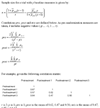How many repeated measures in repeated measures designs? Statistical issues for comparative trials
- PMID: 14580266
- PMCID: PMC280679
- DOI: 10.1186/1471-2288-3-22
How many repeated measures in repeated measures designs? Statistical issues for comparative trials
Abstract
Background: In many randomized and non-randomized comparative trials, researchers measure a continuous endpoint repeatedly in order to decrease intra-patient variability and thus increase statistical power. There has been little guidance in the literature as to selecting the optimal number of repeated measures.
Methods: The degree to which adding a further measure increases statistical power can be derived from simple formulae. This "marginal benefit" can be used to inform the optimal number of repeat assessments.
Results: Although repeating assessments can have dramatic effects on power, marginal benefit of an additional measure rapidly decreases as the number of measures rises. There is little value in increasing the number of either baseline or post-treatment assessments beyond four, or seven where baseline assessments are taken. An exception is when correlations between measures are low, for instance, episodic conditions such as headache.
Conclusions: The proposed method offers a rational basis for determining the number of repeat measures in repeat measures designs.
Figures
References
-
- Van Patten CL, Olivotto IA, Chambers GK, Gelmon KA, Hislop TG, Templeton E, Wattie A, Prior JC. Effect of Soy Phytoestrogens on Hot Flashes in Postmenopausal Women With Breast Cancer: A Randomized, Controlled Clinical Trial. Journal of Clinical Oncology. 2002;20:1449–1455. doi: 10.1200/JCO.20.6.1449. - DOI - PubMed
-
- Frison L, Pocock SJ. Repeated measures in clinical trials: analysis using mean summary statistics and its implications for design. Stat Med. 1992;11:1685–1704. - PubMed
MeSH terms
LinkOut - more resources
Full Text Sources



